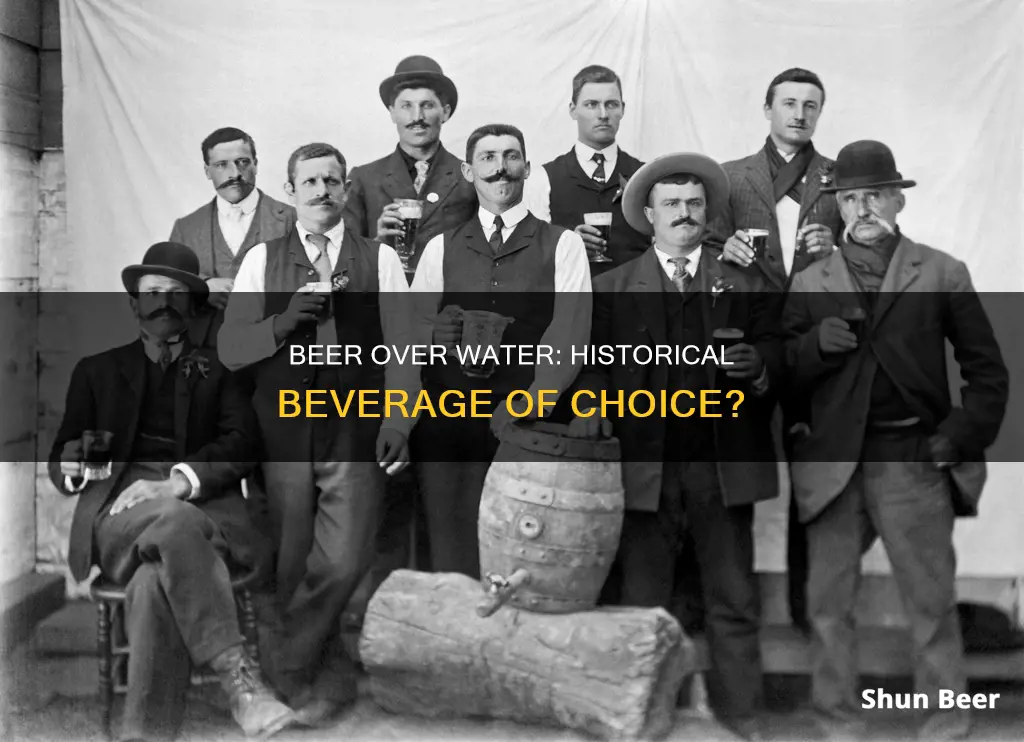
It is a common misconception that people drank beer instead of water in medieval times. In fact, water was free and readily available, with towns and villages built around a water source. People were able to tell the difference between clean and contaminated water, and water infrastructure was in place in many places, including London, which had a complex pipe system by 1237. Beer was seen as a more nutritious alternative to water, providing a boost of energy, but it would have been more costly to drink than water.
| Characteristics | Values |
|---|---|
| Reason for drinking beer | Beer was viewed as a more nutritious alternative to water. |
| Beer was calorie-laden and provided energy. | |
| Beer was a popular choice for workers and farmers who were thirsty and in need of energy. | |
| Water consumption | Water was plentiful and common. |
| Water was free and clean. | |
| People drank water from wells, fresh streams, and public infrastructures in larger towns. | |
| People avoided drinking water that looked or smelled bad. | |
| Water was mixed with wine or sweeteners like honey. | |
| Beer consumption | Beer was commonly used to pay taxes and tithes. |
| Beer was more expensive than water due to taxes and transportation fees. | |
| Beer was consumed by all ages and social classes. | |
| Beer was drunk in the mornings to provide energy for the day. | |
| Beer was easy to make with four main ingredients: water, grain, yeast, and hops. | |
| Beer was seen as having good nutritional value. |
What You'll Learn

Water was free and accessible
Water was free and easily accessible to most people in the Middle Ages. Towns and villages were often built around a water source, such as a well or a fresh stream, which was the centerpiece of the community. In larger towns, there was infrastructure in place to supply water to citizens. For example, London had a complex pipe system in place by 1237, which brought water from a spring to a pumping house, making fresh water available throughout the city.
People were also able to differentiate between clean and contaminated water sources. They would avoid drinking water that looked or smelled bad, and tradespeople who polluted the town's drinking supply faced hefty fines. Medieval people were not drinking water that was visibly or obviously polluted.
Water was also consumed by the wealthy, who could afford to have their own pipes bringing water directly to their homes. Most people, however, would buy buckets of water supplied by water carriers.
Water was also mixed with wine or sweeteners like honey to improve the flavour.
Longmire's Beer Choice: What Brand Does He Prefer?
You may want to see also

Beer was a nutritious snack
While it is a common misconception that people in medieval times drank beer instead of water, beer was in fact viewed as a nutritious snack.
Medieval Europe's relationship with alcohol was not as wild as one might think. Beer during this period was weaker than it is today, with an ABV of around three per cent. As such, people did not drink beer to get drunk but as a source of carbohydrates and calories. For peasants performing hard labour all day, beer was a more nutritious and energy-providing choice than water.
Beer also contained some good-for-you nutrients. According to one study, beer contains more protein and B vitamins than wine. The antioxidant content of beer is equivalent to that of wine, but the specific antioxidants are different because the barley and hops used in the production of beer contain flavonoids different from those in the grapes used in the production of wine. Beer also has significant protein and some fibre. It is one of the few significant dietary sources of silicon, which helps prevent osteoporosis. Preliminary research also suggests that beer may contain prebiotics that feed the good bacteria in our gut.
However, beer was not a replacement for water. Water was free and clean, and people drank it regularly. Most communities understood not to pollute their water sources with human or livestock waste. Even in more densely populated areas, there was infrastructure in place to ensure that clean water was available to citizens. For example, London had developed a complex pipe system by 1237.
In conclusion, while beer was seen as a nutritious snack in medieval times, it was not the primary source of hydration.
Drinking Beer in Spain: What's Allowed in Public?
You may want to see also

Beer was a source of energy
Beer has been an important source of energy and nutrition throughout history. While the notion that people in medieval times drank beer instead of water is a widespread myth, beer was still a significant source of calories and hydration for medieval peasants, who led physically demanding lives.
Beer as a Source of Energy
Beer has been consumed throughout history as a source of energy. Even today, alcohol is considered an energy source, referred to as 'ethanol' in drinks. Ethanol is produced by fermenting the sugars in starch or sugar-based crops such as grains, fruits, and vegetables. This process results in beer from barley, wine from grapes, and vodka from potatoes.
Alcohol is quickly absorbed into the bloodstream and prioritised for digestion over other macronutrients. It is then either used for energy or stored as fat. With seven calories per gram, alcohol is energy-dense but nutrient-poor, and it can prevent the body from properly absorbing and digesting other nutrients.
Beer in Medieval Times
Contrary to popular belief, medieval people did not primarily drink beer instead of water. In fact, water was plentiful and common, as evidenced by various records from that time. Medieval people understood that water could be good or bad and avoided water that looked or smelled bad. They also implemented infrastructure to supply clean water to villages and larger towns. For example, in 1236, construction began on a system of pipes in London to supply fresh water to the city.
While beer may not have been a replacement for water, it was still viewed as a more nutritious alternative. Medieval beer was weakly brewed from barley, but it was calorie-laden, making it a popular choice for workers and farmers who needed energy throughout their labour-intensive days.
Beer as a Modern Energy Drink
Even today, beer is considered a source of energy. A study by Yale University found that heavy drinkers' bodies can accelerate the conversion of alcohol into energy-boosting acetate, especially in the brain. This may also explain the higher tolerance levels among heavy drinkers and why it is challenging for them to abstain from alcohol.
Throughout history, beer has been an important source of energy and nutrition for many cultures. While medieval people did not exclusively drink beer and had access to clean water, beer still played a significant role in their diet, especially for those with physically demanding jobs. Today, beer continues to be enjoyed for its taste and relaxing effects, with non-alcoholic and low-alcohol options also gaining popularity.
Beer and Diatizem: What's the Verdict?
You may want to see also

Water was not avoided out of fear of contamination
It is a common misconception that people in the Middle Ages drank beer instead of water due to water being unsafe to drink. In reality, water was both free and readily accessible, as most towns and villages were built around a water source. People were able to tell the difference between a clean water source and one that might have been contaminated, and medieval communities understood the importance of not polluting their water sources with human or livestock waste.
In larger towns, there was infrastructure in place to supply water to citizens. London, for example, had a complex pipe system in place by 1237, and there were regulations in place regarding the use of dirty water. The notion that water could carry diseases is a fairly modern one, and even the great sewers of Victorian London were originally designed to carry away the "bad airs" thought to cause disease, rather than the polluted water itself.
Water was also consumed by religious figures of the time. One account by Gallo-Roman historian Saint Gregory of Tours mentions a boy so religious that he primarily drank water, and in another story, there were telltale marks where a hermit had knelt to drink from a river. Water was also sometimes mixed with wine or sweeteners like honey, and a 14th-century monk once listed water as a beverage preferred over beer.
While beer was consumed in the Middle Ages, it was not as a replacement for water. Beer was seen as a more nutritious alternative, providing calories and energy, especially for those performing manual labor. It was also used to pay taxes and tithes and was considered to have good nutritional value. However, it would have been more costly to drink than water, as it had to be purchased, while water was free.
Beer and Dark Stool: Is There a Link?
You may want to see also

Beer was a breakfast drink
Small beer was drunk in the mornings to fuel people for their physically demanding jobs ahead. It was a source of calories and hydration, and was seen as having good nutritional value. It was also easy to make, with only four main ingredients: water, grain, yeast, and hops.
While some historians have suggested that people in the Middle Ages drank beer instead of water because water was unsafe, other historians argue that this is a myth. Water was both free and readily accessible, as most towns and villages were built around a water source. People were also able to tell the difference between a clean water source and one that might have been contaminated. In larger towns, there were even infrastructures in place to supply water to citizens, such as the complex pipe system in London by 1237.
Beer Overload: Sore Throat Culprit?
You may want to see also
Frequently asked questions
No, it is a myth that people drank beer instead of water. Beer was consumed alongside water, and water was both free and readily accessible, as most towns and villages were built around a water source.
Beer was viewed as a more nutritious alternative to water. It was calorie-laden and provided energy, making it a popular choice for people with physically demanding jobs.
People were able to tell the difference between a clean water source and one that might have been contaminated. While water in densely populated areas could be polluted, there was infrastructure in place to ensure that clean water was available to citizens.
No, beer was not a replacement for water. Beer was more expensive than water as it had to be purchased, whereas water was free. Beer was often consumed for its nutritional value and energy-boosting properties.
Beer was an important part of medieval culture. It was commonly used to pay taxes and tithes, and it was also a popular drink during celebrations and feasts. However, it was not the only drink available, and water was also widely consumed.







